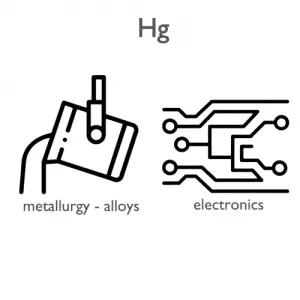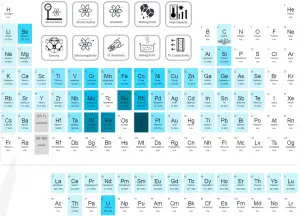About Mercury
Mercury is commonly known as quicksilver and was formerly named hydrargyrum. Mercury is a heavy, silvery d-block element, mercury is the only metallic element that is liquid at standard conditions for temperature and pressure
Summary
| Element | Mercury |
| Atomic number | 80 |
| Element category | Transition Metal |
| Phase at STP | Liquid |
| Density | 13.534 g/cm3 |
| Ultimate Tensile Strength | N/A |
| Yield Strength | N/A |
| Young’s Modulus of Elasticity | N/A |
| Mohs Scale | N/A |
| Brinell Hardness | N/A |
| Vickers Hardness | N/A |
| Melting Point | -38.9 °C |
| Boiling Point | 357 °C |
| Thermal Conductivity | 8.3 W/mK |
| Thermal Expansion Coefficient | 60.4 µm/mK |
| Specific Heat | 0.139 J/g K |
| Heat of Fusion | 2.295 kJ/mol |
| Heat of Vaporization | 59.229 kJ/mol |
| Electrical resistivity [nanoOhm meter] | 961 |
| Magnetic Susceptibility | −33.4e-6 cm^3/mol |
Applications of Mercury
Mercury is used primarily for the manufacture of industrial chemicals or for electrical and electronic applications. However, because of its toxicity, many uses of mercury are being phased out or are under review. It is used in some thermometers, especially ones which are used to measure high temperatures. Mercury easily forms alloys, called amalgams, with other metals such as gold, silver and tin. The ease with which it amalgamates with gold made it useful in recovering gold from its ores. Mercury amalgams were also used in dental fillings. Gaseous mercury is used in mercury-vapor lamps and some “neon sign” type advertising signs and fluorescent lamps.
Production and Price of Mercury
Raw materials prices change daily. They are primarily driven by supply, demand and energy prices. In 2019, prices of pure Mercury were at around 50 $/kg.
The price of mercury has been highly volatile over the years and in 2006 was $650 per 76-pound (34.46 kg) flask. Mercury is extracted by heating cinnabar in a current of air and condensing the vapor. The equation for this extraction is: HgS + O2 → Hg + SO2 In 2005, China was the top producer of mercury with almost two-thirds global share followed by Kyrgyzstan. Several other countries are believed to have unrecorded production of mercury from copper electrowinning processes and by recovery from effluents.
Source: www.luciteria.com
Mechanical Properties of Mercury
Strength of Mercury
In mechanics of materials, the strength of a material is its ability to withstand an applied load without failure or plastic deformation. Strength of materials basically considers the relationship between the external loads applied to a material and the resulting deformation or change in material dimensions. In designing structures and machines, it is important to consider these factors, in order that the material selected will have adequate strength to resist applied loads or forces and retain its original shape. Strength of a material is its ability to withstand this applied load without failure or plastic deformation.
For tensile stress, the capacity of a material or structure to withstand loads tending to elongate is known as ultimate tensile strength (UTS). Yield strength or yield stress is the material property defined as the stress at which a material begins to deform plastically whereas yield point is the point where nonlinear (elastic + plastic) deformation begins.
See also: Strength of Materials
Ultimate Tensile Strength of Mercury
Ultimate tensile strength of Mercury is N/A.
Yield Strength of Mercury
Yield strength of Mercury is N/A.
Modulus of Elasticity of Mercury
The Young’s modulus of elasticity of Mercury is N/A.
Hardness of Mercury
In materials science, hardness is the ability to withstand surface indentation (localized plastic deformation) and scratching. Brinell hardness test is one of indentation hardness tests, that has been developed for hardness testing. In Brinell tests, a hard, spherical indenter is forced under a specific load into the surface of the metal to be tested.
Brinell hardness of Mercury is approximately N/A.
The Vickers hardness test method was developed by Robert L. Smith and George E. Sandland at Vickers Ltd as an alternative to the Brinell method to measure the hardness of materials. The Vickers hardness test method can be also used as a microhardness test method, which is mostly used for small parts, thin sections, or case depth work.
Vickers hardness of Mercury is approximately N/A.
Scratch hardness is the measure of how resistant a sample is to permanent plastic deformation due to friction from a sharp object. The most common scale for this qualitative test is Mohs scale, which is used in mineralogy. The Mohs scale of mineral hardness is based on the ability of one natural sample of mineral to scratch another mineral visibly.
Mercury is has a hardness of approximately N/A.
See also: Hardness of Materials
Mercury – Crystal Structure
A possible crystal structure of Mercury is rhombohedral structure.
In metals, and in many other solids, the atoms are arranged in regular arrays called crystals. A crystal lattice is a repeating pattern of mathematical points that extends throughout space. The forces of chemical bonding causes this repetition. It is this repeated pattern which control properties like strength, ductility, density, conductivity (property of conducting or transmitting heat, electricity, etc.), and shape. There are 14 general types of such patterns known as Bravais lattices.
See also: Crystal Structure of Materials
Crystal Structure of Mercury

Thermal Properties of Mercury
Mercury – Melting Point and Boiling Point
Melting point of Mercury is -38.9°C.
Boiling point of Mercury is 357°C.
Note that, these points are associated with the standard atmospheric pressure.
Mercury – Thermal Conductivity
Thermal conductivity of Mercury is 8.3 W/(m·K).
The heat transfer characteristics of a solid material are measured by a property called the thermal conductivity, k (or λ), measured in W/m.K. It is a measure of a substance’s ability to transfer heat through a material by conduction. Note that Fourier’s law applies for all matter, regardless of its state (solid, liquid, or gas), therefore, it is also defined for liquids and gases.
Coefficient of Thermal Expansion of Mercury
Linear thermal expansion coefficient of Mercury is 60.4 µm/(m·K)
Thermal expansion is generally the tendency of matter to change its dimensions in response to a change in temperature. It is usually expressed as a fractional change in length or volume per unit temperature change.
Mercury – Specific Heat, Latent Heat of Fusion, Latent Heat of Vaporization
Specific heat of Mercury is 0.139 J/g K.
Heat capacity is an extensive property of matter, meaning it is proportional to the size of the system. Heat capacity C has the unit of energy per degree or energy per kelvin. When expressing the same phenomenon as an intensive property, the heat capacity is divided by the amount of substance, mass, or volume, thus the quantity is independent of the size or extent of the sample.
Latent Heat of Fusion of Mercury is 2.295 kJ/mol.
Latent Heat of Vaporization of Mercury is 59.229 kJ/mol.
Latent heat is the amount of heat added to or removed from a substance to produce a change in phase. This energy breaks down the intermolecular attractive forces, and also must provide the energy necessary to expand the gas (the pΔV work). When latent heat is added, no temperature change occurs. The enthalpy of vaporization is a function of the pressure at which that transformation takes place.
Mercury – Electrical Resistivity – Magnetic Susceptibility
Electrical property refers to the response of a material to an applied electric field. One of the principal characteristics of materials is their ability (or lack of ability) to conduct electrical current. Indeed, materials are classified by this property, that is, they are divided into conductors, semiconductors, and nonconductors.
See also: Electrical Properties
Magnetic property refers to the response of a material to an applied magnetic field. The macroscopic magnetic properties of a material are a consequence of interactions between an external magnetic field and the magnetic dipole moments of the constituent atoms. Different materials react to the application of magnetic field differently.
See also: Magnetic Properties
Electrical Resistivity of Mercury
Electrical resistivity of Mercury is 961 nΩ⋅m.
Electrical conductivity and its converse, electrical resistivity, is a fundamental property of a material that quantifies how Mercury conducts the flow of electric current. Electrical conductivity or specific conductance is the reciprocal of electrical resistivity.
Magnetic Susceptibility of Mercury
Magnetic susceptibility of Mercury is −33.4e-6 cm^3/mol.
In electromagnetism, magnetic susceptibility is the measure of the magnetization of a substance. Magnetic susceptibility is a dimensionless proportionality factor that indicates the degree of magnetization of Mercury in response to an applied magnetic field.


























